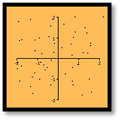Point DefinitionPoints and lines are the abecedarian principles in the figure that we must master before we can learn about other forms and sizes. Because it simply represents a dot, a point is a dimensionless shape, whereas a line is a - dimensional object. Both points are lines that draw colorful forms and sizes in a plane. These shapes might be in two or three confines. A point and a line are basic points geometry concepts. A point is a position with no width, height, or length and is also zero-dimensional. It is denoted by a dot and is given a capital letter. (For instance, A line or straight line is connected indefinitely to several points that are extended in opposite directions.) A line segment AB, denoted by the symbol AB, is called using any two points. 
The geometric figures can be labeled and identified using a point, and the figures can be drawn using lines. Points are utilized in various applications, including graphing and map reading. Almost all geometry starts with a point, whether it's a line or a complex three-dimensional structure. Lines, rays, 2D shapes, and angles are all drawn with points. A kite stick is a simple example of a point because the two sticks of a kite intersect at a point. What's the Point?A point is a dot on a plane or a piece of paper. A point has no length, range, or height. It determines the position or position of a plane. To make a point, draw a dot on a piece of paper and mark it with A or another capital letter. Put three blotches on a piece of paper and label them X, Y, and Z to indicate three different points. They can be read as points X, Y, and Z. Types of point1. Colinear PointsAs the name implies, colinear points are direct. Collinear points are points in a direct portion or on a straight line. The gap means" together" in Latin. So collinear implies gap direct indicate points that are connected linearly. 2. Non-collinear PointsNon-collinear, as the name suggests, means non-linear. A non-collinear point is a straight-line segment or a point that is not on a straight line. Examples of non-collinear points: A simple example can illustrate non-collinear points. If you take a few points, try to draw a single straight line, and fail, you have a non-collinear point. 3. Concurrent PointsA concurrent point is formed when two or further lines cross at a spot. Consider the points P, Q, R, and S, as well as the line P- R- S crossed at point A. This point, A, is appertained to be a concurrent point. 4. Points that are coplanarAs the name implies, coplanar points lie on a plane. A minimum of three points are required to check coplanar points. According to the three-dimensional figures, all three points are coplanar. Coplanar Point example -Consider four points on a table; this signifies that all the points are on the table's surface. As a result, these are coplanar points. Coordinates of a pointA point's coordinates are pairs of numbers that define its exact location on a two-dimensional plane. Note that the coordinate plane has two mutually perpendicular axes, the x-axis and the y-axis. The coordinates of a particular point give the point's distance along each axis. Pair that has been orderedThe coordinates are represented as "ordered pairs." P represents the point's name and distinguishes it from other points. Ordered pairs giving the coordinates of the pointsThe numbers in brackets represent the x and y coordinates of the point. The first number (x) indicates how far the location is along the x-axis (horizontally). The second is the y-coordinate, which defines how much the y-axis moves up or down. Because the order of the two integers is important (the first integer is always the x-coordinate (horizontal)), we describe ordered pairs. The coordinate's sign is critical. A positive number indicates that you should proceed to the right (x) or up (y). Negative numbers indicate that you should travel left (x) or down (y).
Next TopicPower Definition
|
 For Videos Join Our Youtube Channel: Join Now
For Videos Join Our Youtube Channel: Join Now
Feedback
- Send your Feedback to [email protected]
Help Others, Please Share










